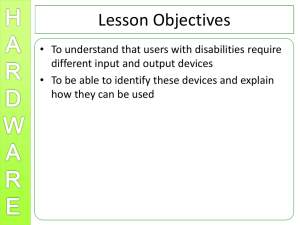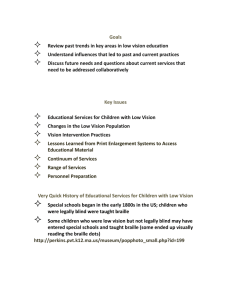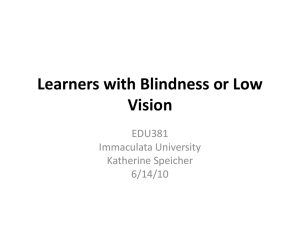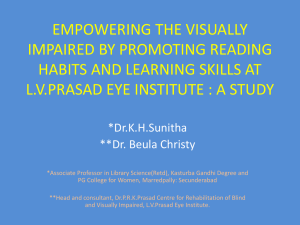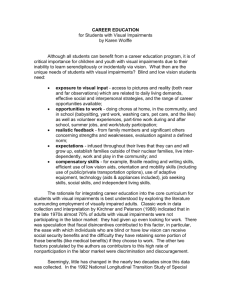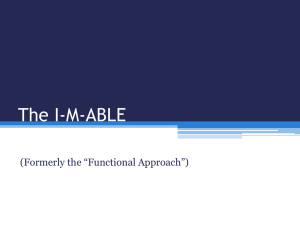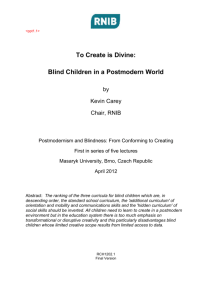teaching young children with visual impairments in head start settings
advertisement
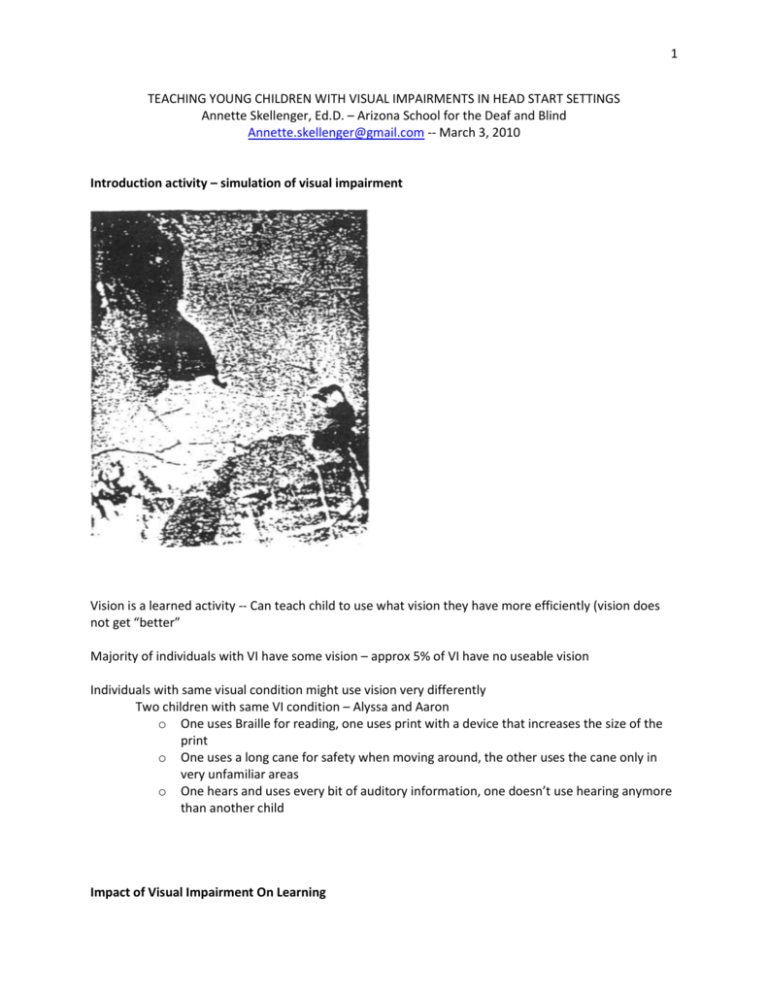
1 TEACHING YOUNG CHILDREN WITH VISUAL IMPAIRMENTS IN HEAD START SETTINGS Annette Skellenger, Ed.D. – Arizona School for the Deaf and Blind Annette.skellenger@gmail.com -- March 3, 2010 Introduction activity – simulation of visual impairment Vision is a learned activity -- Can teach child to use what vision they have more efficiently (vision does not get “better” Majority of individuals with VI have some vision – approx 5% of VI have no useable vision Individuals with same visual condition might use vision very differently Two children with same VI condition – Alyssa and Aaron o One uses Braille for reading, one uses print with a device that increases the size of the print o One uses a long cane for safety when moving around, the other uses the cane only in very unfamiliar areas o One hears and uses every bit of auditory information, one doesn’t use hearing anymore than another child Impact of Visual Impairment On Learning 2 Learning occurs in manner opposite to how learning occurs with sight Whole to part (sighted) – part to whole (severely visually impaired) Vision is the main integrating sense – normally we need to look at something to understand that the sight, sound, smell, feel all go together into the same entity Vision is not just taking info into the eye Refer to picture of eye, visual pathways, brain on last page of this handout Population of individual’s with visual impairments is even more heterogeneous than typical populations Age + culture + prior experiences + male/female + parenting style + inherited traits + motivation/interest/self-concept location eyeball + location pathway + location brain + degree = Factors affecting learning Less motivation -- Vision is typically the primary motivator Infant reflexively stretches out arm and accidentally hits mobile over crib – child is motivated to try to replicate the action he sees in the mobile Young child watches another person then tries to replicate or vary what was seen Child gets the pleasure of seeing what his action has accomplished and this spurs him on to try again, or eventually to vary the action to see what it accomplishes Child sees something he wants and figures out a way to move to get it Less opportunity for learning Incidental learning Imitative learning Probability of developing self-stimulating behaviors Less “depth” from remaining senses Other senses do not covey range of complexity Other senses do not give information about where the sense emanates from (except sound) Other senses do not act as integrating sense Limitation in Range And Variety Of Experiences What to do? What to do? Solicit help from Teacher of Children with Visual Impairments and/or Orientation and Mobility Specialist Teacher of Children with Visual Impairments 3 o o o o Facilitates access to what others are learning by providing materials in Braille, large print or other adapted formats, and by suggesting adapted ways to present information and teach skills Directly teaches “vision specific” skills such as tactile and auditory discrimination, Braille reading and writing, tactual math code, daily living skills, social skills o Orientation and Mobility Specialist (O&M) Teaches methods and devices that provide safe movement Teaches cognitive skills to help individual know where they are and how to get where they want to go Start Early Provide safe and predictable environments Sighted guide or human guide is a method to for an individual with visual impairments to move safely and efficiently with another person o Child holds on to the wrist of the guide, keeps upper arm close to body, and walks about a step and a half behind the guide Facilitate vision use when available Give as many real experiences as possible Use accurate language Maintain normal expectations (unless there are additional impairments) Resources www.afb.org – American Foundation for the Blind – agency that acts as the main “clearinghouse” for all types of information about blindness and visual impairments. www.aph.org – American Printing House for the Blind – main resource for production of materials to support instruction of children with visual impairments www.tsbvi.edu – Texas School for the Blind – one of the main providers of professional resources for teachers of the blind. Most materials are very practical and user friendly. See example of information taken from their website below on making story boxes for children who are blind Fazzi & Pogrund. (2002 ). Early Focus. NY: American Foundation for the Blind Early intervention has increasingly been recognized as critical in the development and growth of children with visual impairments and other disabilities. Federal regulations have mandated early identification and assessment, underscoring its importance for children's well-being. This newly revised and updated edition of Early Focus, provides the important information you need to know, including: * How to deliver services to children with multiple disabilities and to families that are culturally diverse. * Four new chapters covering the delivery of early intervention services, and developing skills in young children in the areas of literacy, daily living and independence, and motor behavior * Strategies, tips, and focus boxes that provide practical information you can apply directly to your work 4 wwwx.cs.unc.edu/~gb/wp/research/hark-the-sound Hark The Sound is a really simple sound game intended for young kids who are visually impaired or blind. It was inspired by my friend and colleague Diane Brauner and was written with help and ideas from many students. It is free for educational and fun use. Downloadable for free. Naming Games, Category Games, Movement/Learning Games http://soesd.k12.or.us/sectionindex.asp?sectiondi=132 -- The Oregon Project for Preschool Children who are Blind or Visually Impaired (The OR Project) is a comprehensive assessment and curriculum designed for use with children birth to six who are blind or visually impaired. It can be used by parents, teachers, vision specialists, or counselors in the home or in the classroom setting. http://anchorcenter.org -- Anchor Center is an organization in Denver that serves preschool children with visual impairments. Their web-site has numerous resources for both parents and teachers for activities to do with young children, as well as many other links related to individuals with visual impairments. Example of suggestions available on Texas School for the Blind’s web-site Home | Site TOC | Site Search | VMI | What is a Story Box? From: NAVPI newsletter - Awareness - Summer 97 What is a Story Box? pages 24, 25 Do It yourself Hands-On Storytime Storyboxes: A Hands-On Literacy Experience compiled by Norma M. Drissel, teacher Perkins School for the Blind A story box is a way for young children with visual impairments to experience a story. When selecting a story for you child, choose one that is simple and tells about familiar objects and concepts. Collect corresponding items in a box or bag. As you read the story to you child, allow him/her to hold the item. The number of items and complexity of the story should be suited to your child. Often, simple is better. Enjoy! Chicka, Chicka, Boom, Boom, by Bill Martin Jr. and John Archambault, National Braille Press, Simon & Schuster, (Print/Braille) Contents Magnetic Braille Alphabet, Drum, Coconut Jennifer's Messes, by Suzette Wright, American Printing House for the Blind. Contents: Cheerios, Barrettes, (2) Coins, Comb, Pencil, Keys, Doll, Pretzel Giggiy-Wiggly, Snickety Snick, by R. Supraner, Parents' Magazine Press. Contents Hard, Soft, Bumpy, Smooth, Tickly, Sharp, Sticky, Stretch, Cold, Hot, Crunchy, Squishy, Fluffy, Curly, Straight. 5 Good Night, Everyone! By H. Ziefert, Little, Brown & Co. Contents Stuffed Animals (Bear, Monkey, Mouse, Lamb). Hello Kitty's Bedtime Search, by S. Bright, Random House. Contents Socks, Necklace, Tee Shirt, Blanket, Teddy Bear. If You Give A Mouse A Cookie, By Laura Joffe Numeroff, Harper & Row. Contents Cookie, Cup, Milk Container, Straw, Mirror, Scissors, Dustbroom, Sponge, Blanket, Pillow, Crayons, Tape, Paper Listen to the Rain, by Bill Martin Jr, National Braille Press, Albert Whitman & Co., (Print/Braille) Contents Tape of Rain Sounds, Raincoat, Boots. Not Yet, Yvette, by Hellen Kettemen, National Braille Press, Holt Co., (Print/Braille) Contents Bowl, Cake Pan, Balloon, Cups, Plates, Forks, Scissors, Gift Wrap, Streamers, Measuring Spoons, Candles, Feather Dusters. Rolly Polly Man, by Suzette Wright, American Printing House for the Blind. Contents Play Dough Strega Nona, by Tommie de Paola, National Braille Press, (Print/Braille) Contents Pasta, Pot with Lid, Bowl, Fork. Suppertime with Frieda Fuzzypaws, by Cyndy Skekeus. Contents Cookies, Plate, Cup, Pasta, Paper Crayon, Paper Cookie. Teddy And The Mice, by Brain Ax, Terry's Friend's Series (Board Book). Contents: Small Wagon or Dump Truck, Blocks, Mice, Nuts, Teddy Bear The Foot Book, by Dr. Seuss, Random House. Contents Slippers, Towels, Cotton Balls, Toy Clown, Big Shoes/Small Shoes. The Gingerbread Man, A Pudgy Pals Board Book. Contents Cookie, Cookie Cutter (Tin), Stuffed Fox, Cat, Cow The Indoor Noisy Book, by M. W. Brown, Harper & Row. Contents Household Objects That Make Sound: Broom, Spoons Clinking, Door Slamming, Eating Raw Carrots or Celery, Slurping Pudding, Footsteps, Telephone Ringing. The Jacket I Wear In The Snow, by Shirely Nellzel, Scholastic Press. Contents Red Wool Hat and Scarf, Zippered Jacket, Sweater, Boots, Long Underwear, Socks, Jeans. The Little Engine That Could, by Watty Piper, Platt & Munk Publishers. Contents Dolls, Balls, Toy Engine, Sailboats, Toy Animals, Clown The Longest Noodle, by Suzette Wright, American Printing House for the Blind. Contents Noodle, Fork, Shoelace, Jump Rope, Ribbon, Yarn. 6 The Runaway Bunny, by Margaret Wise Brown, Harper & Row. Contents Toy Fish, Rock, Gardening Tools, Watering Can, Toy Bird, Sailboat, StuffedBunny, Carrot. The Saucepan Game, by J. Ormerod., Lee & Shepard Books. Contents Pan with a Lid, Stuffed Toy Cat. The Sweet Smells of Christmas, by Patricia Scarry, (Scratch and sniff). Golden Press Contents Cinnamon, Pine Cone, Candy Cane, Spirit of Peppermint, Ginger, Cocoa The Three Little Kittens, by Kate Gleeson, Golden Books. Contents (3) Stuffed Kittens, (3) Small Pie Tins, Soap, Mittens; Optional Clothes Line & Clips. The Three Little Pigs, Golden Sound Story, Golden Press. Contents Brick, Sticks, Hammer, Hat, Straw. Underwear, by Mary Elise Monsell, National Braille Press, (Print/Braille) Contents Different Kinds of Underwear, Slippers. There are many kinds of books for young children with visual impairment. If you child has little or no functional vision, you may want to try a variety of approaches. o o o o o o o o Make up stories. Keep it simple and use real objects that are familiar to your child. Try homemade books. Use cardboard and glue, tie or velcro objects to the book. Scented items are always fun. Most children like stories about their own familiar routine, e.g. going to the store, taking a bath, eating a meal, etc. For young children, choose predictable books with repetitive phrases. Even young children enjoy poetry and rhymes. Young children with short attention spans need short books. Tactile Books ("Pat the Cat, The Touch Me Book, etc.) are both durable and portable. Scratch and sniff books add an interesting dimension. Books with auditory components can be made made accessible by adding a little texture here and there (try a little velcro where you need to press to activate). Story Boxes are enjoyable to experience at all ages and can be adapted to the child's level. They provide a fine opportunity for concept development 7

